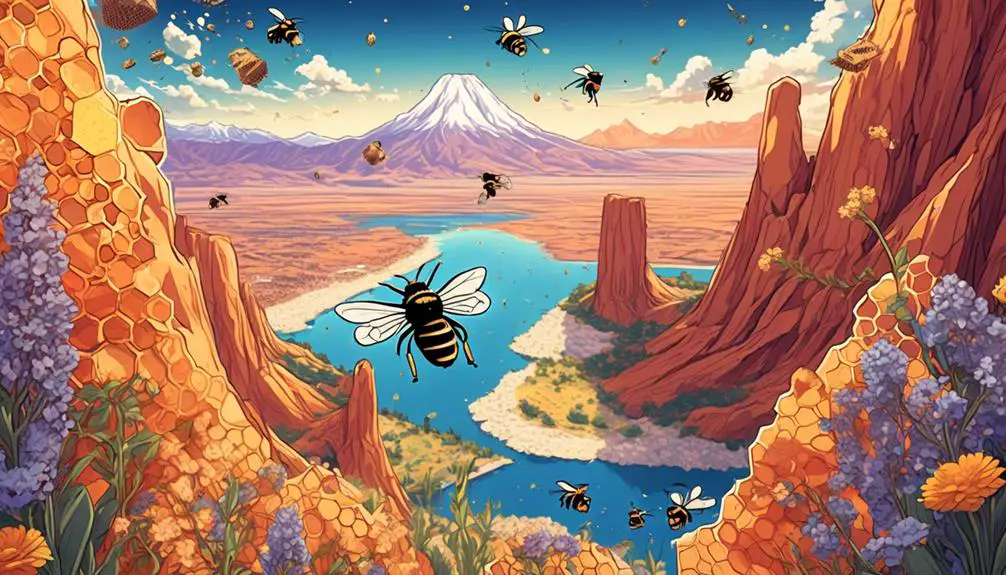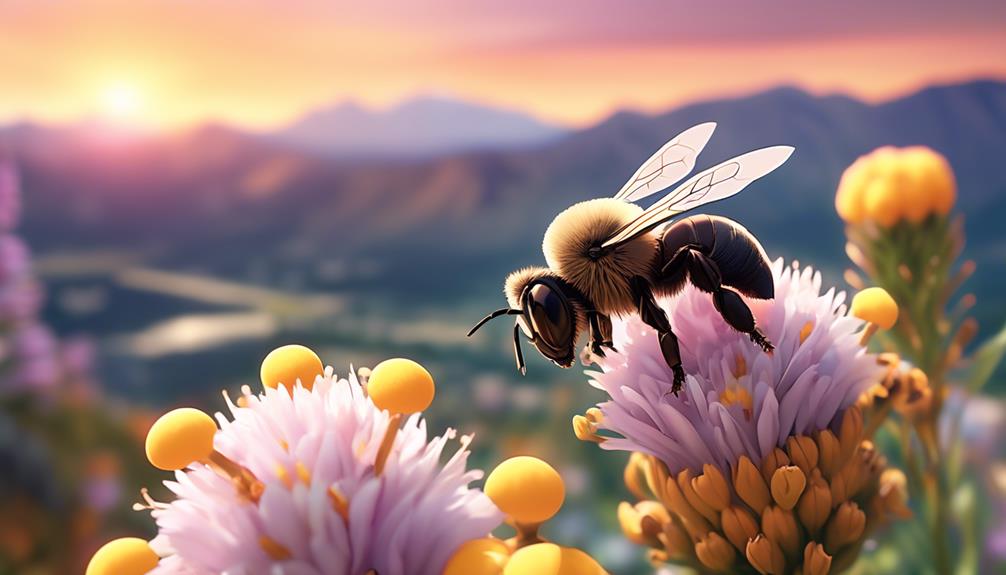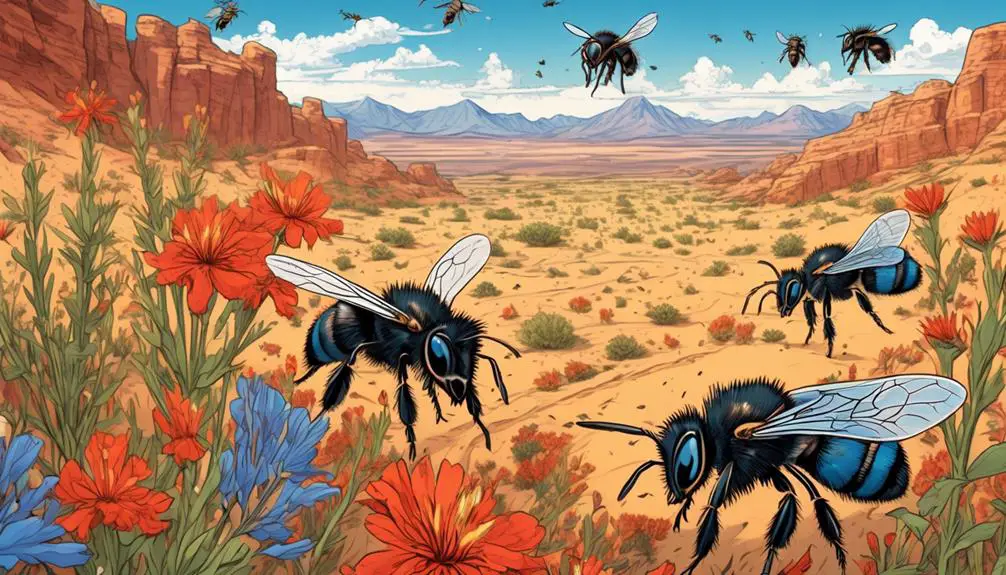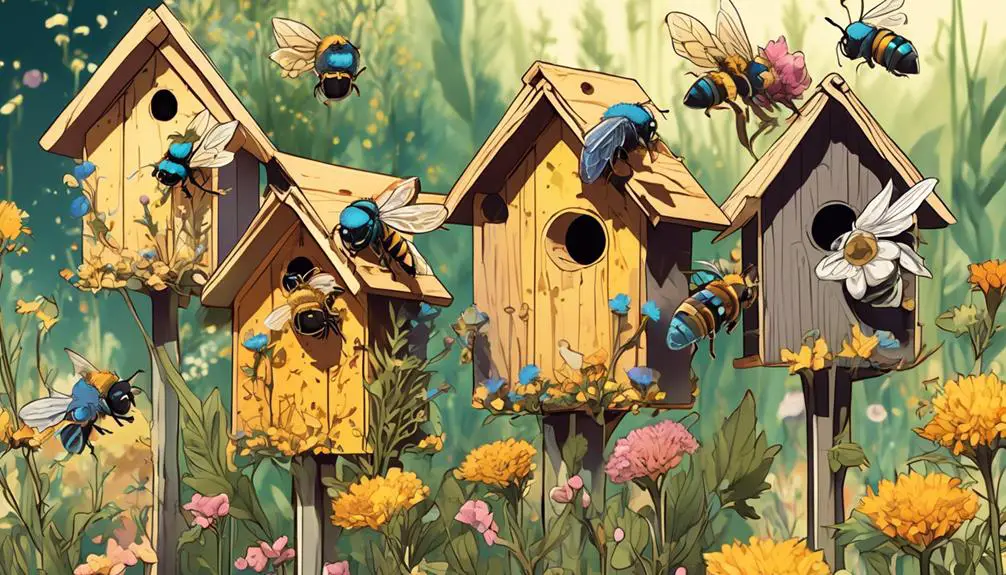Yes, mason bees are native to Utah, but let's dive into their ecological significance and intriguing migration patterns.

Are Mason Bees Native to Utah?
Buzzing bees bring to mind the blissful beauty of nature, don't they?
You must have seen these tiny, tireless workers in your garden, but have you ever wondered about their origin? Specifically, the Mason bees – are they native to Utah?
It's a question that might seem simple, but when you start to dig into the details, it becomes a fascinating exploration of ecology, migration patterns, and the complex relationships between species and their environments.
Are you ready to take on the challenge, to unravel this intriguing insect mystery?
Key Takeaways
- Mason bees are native to Utah and play an important role in the state's ecosystem.
- They are efficient pollinators and contribute to plant diversity.
- Mason bees face threats such as predation, parasites, habitat destruction, pesticides, and climate change.
- To encourage Mason bees in Utah, plant native bee-friendly plants, set up bee houses, avoid pesticides, and provide suitable nesting sites.
Understanding Mason Bees

To fully appreciate the role of Mason bees in Utah's ecosystem, it's essential to start by understanding their unique biology and behavior. Unlike honeybees, Mason bees are solitary creatures. Each female is fertile and constructs her own nest, rather than living in a colony with a queen and workers. You'll find them nesting in small cavities, often in wood or hollow stems, where they create partitions between their eggs using mud – hence their name.
In terms of their contribution to the ecosystem, you must know that Mason bees are highly efficient pollinators. In fact, they're considered more effective than honeybees. They carry pollen on their abdomen, which makes contact with flowers more frequently. Moreover, they're not picky eaters. They'll pollinate a variety of plants, contributing to plant diversity and overall ecosystem health.
Their behavior also makes them less threatening to humans. Mason bees rarely sting unless they're trapped or squeezed, making them safe neighbors in urban environments.
Mason Bees' Native Regions

While the value of Mason bees in Utah's ecosystem is significant, it's equally fascinating to examine the diverse regions these capable pollinators naturally inhabit. Mason bees have a broad geographical range spanning North America, Europe, and Asia. They're not picky about their habitat, which explains their wide distribution.
In North America alone, there are over 130 species of Mason bees. They're found from the frigid zones of Alaska and Canada, down to the balmy climates of Mexico. They're particularly abundant in the western United States, including Utah, where they play a crucial role in the local ecosystems.
Across the Atlantic, Mason bees thrive in the varying climates of Europe, from the Mediterranean to the Arctic Circle. They've adapted to a range of environments, from bustling cities to quiet countryside. Asia also hosts a diverse population of these bees, particularly in temperate regions.
That's the beauty of Mason bees – their adaptability. Whether it's the harsh deserts of Utah or the damp forests of Asia, they've found a way to thrive. You'll find them buzzing around, diligently pollinating and contributing to local ecosystems. No matter where you are, chances are, there's a Mason bee nearby.
Mason Bees in Utah's Ecosystem

In Utah's diverse ecosystem, you'll find Mason bees working tirelessly, playing an integral role in pollination and plant reproduction. These small powerhouses are essential to the thriving flora you see throughout the state. They're solitary bees, meaning they don't live in hives like honeybees but set up individual nests in holes or crevices.
You mightn't know this, but Mason bees are superior pollinators compared to honeybees. They carry pollen on their abdomen, which leads to more effective cross-pollination as they move from flower to flower. They're also not picky about the flowers they visit, which results in a wide variety of plants getting pollinated.
Mason bees contribute to Utah's ecosystem by maintaining biodiversity. Their pollination efforts support a broad range of plant species, which in turn provides habitats and food for other wildlife. Furthermore, they're early spring pollinators, so they help plants that bloom early in the year when other pollinators aren't active yet.
In a nutshell, Mason bees are small but mighty contributors to Utah's ecosystem. Next time you're admiring Utah's beautiful landscapes, remember the Mason bees that play a crucial role in maintaining it.
Threats to Utah's Mason Bees

Despite their significant role in Utah's ecosystem, Mason bees face a myriad of threats that could potentially hinder their pollination efforts and overall contribution to biodiversity.
You must understand that these bees are under constant siege from various sources, both natural and man-made.
Predation is a significant threat. Birds, insects, and spiders are known to feed on Mason bees, greatly reducing their population. Parasites, too, are a major concern. Chalcid wasps, for instance, lay their eggs inside Mason bee larvae, leading to their death.
Habitat destruction is another serious issue. As urbanization expands, the natural habitats of Mason bees are being lost. They're dependent on specific plants for nectar and pollen, and the loss of these plants directly affects their survival.
Pesticides are also a major threat. They're often used in agriculture and gardening, and exposure can be lethal to Mason bees. Even sub-lethal exposure can impact their ability to navigate and reproduce.
Climate change, too, poses a threat. Changes in temperature and precipitation can disrupt their lifecycle and may lead to local extinctions.
In short, Mason bees are under siege, and their survival in Utah is far from guaranteed.
Encouraging Mason Bees in Utah

You can play a vital role in protecting and encouraging the population of Mason bees in Utah through various environmentally-conscious practices. These practices revolve around providing an accommodating environment for the bees, supplying them with adequate food sources, and ensuring they have suitable nesting sites.
Create bee-friendly gardens by planting Utah's native plants that bloom throughout the bee season. These plants will serve as a consistent food supply for the Mason bees.
Here's a simple guide:
Plant | Season |
|---|---|
Pussy Willow | Early Spring |
Blueberries | Spring |
Lavender | Summer |
Sunflowers | Late Summer |
Goldenrod | Fall |
Additionally, you can set up a Mason bee house. They prefer nesting in small cavities, so drill holes in untreated wood or use hollow stems. Just make sure to place the house in a sunny, east-facing location.
Avoid using pesticides in your garden. They can harm the bees, disrupting their foraging and nesting behaviors.
Conclusion
Indeed, Mason bees are native to Utah and play a vital role in its ecosystem. However, they're under threat from habitat loss and pesticides.
Your actions can make a difference. By creating bee-friendly environments in your garden, you're helping to protect these industrious pollinators.
So, let's roll up our sleeves and do our bit for Utah's Mason bees, ensuring their survival for the benefit of our environment and future generations.


